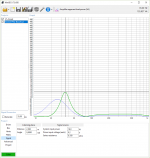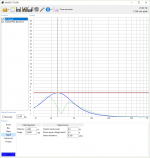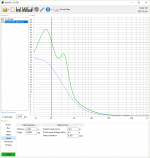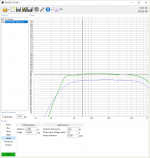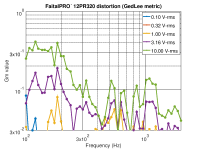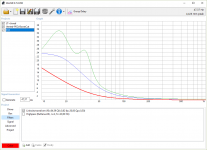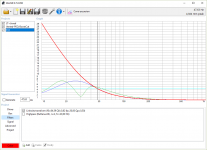- anyone having experience with the subject or who just wants to leave his critical comment concerning the sound quality within the limiting factors given is pretty much welcome to discuss the pros and cons of the active assists -
I am planning a too small box for a 2-way topology speaker.* My very personal domestic acceptance factor** allows for about 45 liters, gross dimensions being centimeters 60 × 34 × 30 (H×W×D). This is too small for a pro driver which is supposed to do the work from ~ 1.2/1 kHz downwards. There is two solutions to my knowledge, given the box volume is set and the topology is not changed:
- 1) A Linkwitz-Transform shelf-filter EQ of a sealed enclosure. Can only be achieved true active.
- 2) Parametrical equalizing of a vented enclosure, Q=2, slightly above very low tuning frequency. Can be achieved active or passive + EQ. Don Keele wrote about it 1975, AES paper attached. Lowcut is necessary to prevent high cone excursion below tuning frequency. This leads to very high group delay in low frequencies.
With the Hypex Amps both can be done. Before I chose to go active because of the time alignement of the drivers, I found the FaitalPro 12PR320 driver to be a very good choice for the woofer. Vented was still the idea then. Taking this driver as a start for comparison of both solutions, the question is what happens to sound reproduction. Here are two examples which take the Xmax of the driver as the limiting factor and power consumption on the other hand:***
Example for Version 1), a LT sealed:
If the LT is set to F3 @35 Hz, cone excursion peaks at 25 Hz and 7.3 mm within Xmax with a system input power (Win ISD) of 8 watts which translates into ~ 85 watts drawn for bass reproduction on each channel. Group delay is ~ 20 ms @ 20 Hz. 95 dB will be reached at a listening position 2.5 meters from the speakers (couch).
Example for Version 2), Boost-Cut vented PEQ:
With a box tuning of 30 Hz, a Q=2, +10 dB @ 35 Hz, 21 watts would be maximum system input power before Xmax is reached, but the amplifier load is already exceeding the specifications of FA123 bridged-mode (125 watts into 8 ohm), so it has to be limited to 16 watts system input power to avoid clipping at 125 watts amplifier load for bass reproduction. Xmax reaches 6.1 mm below and 4.3 mm above tuning frequency. SPL at listening position is naturally higher than Version 1 at 98 dB. But Group delay exceeds 30 ms below 20 Hz, up to 35 ms!
This means: version 1 (LT-sealed) is fundamentally limited by Xmax, while version 2 (vented PEQed) with a +10 dB @35 Hz is limited by power alone. But it needs considerable amounts of power to be extended to reach Xmax (165VA @ 35 Hz or 16 watts system input power, compared to half the peak value of 86VA with LT). Then, it could play up to 99 dB at a 2.5 meter listening position, whilst Group delay reaches 35 ms at the threshold of low frequency audibility at 16 Herz. This can easily be audible.
Also, for very high listening levels bass extension can be sacrificed (which can be done with switchable presets within FA123, either as a decrease of EQ boost or as a higher-F3-Linkwitz transform).
The trade-offs of both designs:
- Lower Group Delay (V1) versus less Cone Excursion (V2)
- Lesser Power consumption (V1) versus higher SPL (V2)
Is there measurements available on the impact of LT/Low-Boost EQ on distortion? I would like to see the rate to which it is rising with increase of Xmax and power. I suppose cone excursion will affect higher frequencies as distortion, what sort of distortion? Intermodular? The vented version can be louder but it has a much higher group delay which may be audible, although it is reaching critical levels very low and exceeds them at the limits of low-frequency audibility for Humans. Do you see other trade-offs which I did not mention? Which direction is the compromise for better sound in your opinion?
________
* CD + horn/waveguide and 12-inch pro woofer, each a Hypex FusionAmp 123 plate amp. So far, so conservative.
** Not related to my partner or any person I would share the appartment with. And not at all to the their gender, as this is not the reason why I would not want to build a ridiculously large monument into my own living room.
*** The driver has Xmax 7.5 mm and high power handling. The Fusion FA123 in bridged mode has a good amount of power too (~125 watts into 8 ohm). The driver (EBP 107) can therefore work in a sealed enclosure, Linkwitz transformed, or in a vented enclosure EQ-boosted.
I am planning a too small box for a 2-way topology speaker.* My very personal domestic acceptance factor** allows for about 45 liters, gross dimensions being centimeters 60 × 34 × 30 (H×W×D). This is too small for a pro driver which is supposed to do the work from ~ 1.2/1 kHz downwards. There is two solutions to my knowledge, given the box volume is set and the topology is not changed:
- 1) A Linkwitz-Transform shelf-filter EQ of a sealed enclosure. Can only be achieved true active.
- 2) Parametrical equalizing of a vented enclosure, Q=2, slightly above very low tuning frequency. Can be achieved active or passive + EQ. Don Keele wrote about it 1975, AES paper attached. Lowcut is necessary to prevent high cone excursion below tuning frequency. This leads to very high group delay in low frequencies.
With the Hypex Amps both can be done. Before I chose to go active because of the time alignement of the drivers, I found the FaitalPro 12PR320 driver to be a very good choice for the woofer. Vented was still the idea then. Taking this driver as a start for comparison of both solutions, the question is what happens to sound reproduction. Here are two examples which take the Xmax of the driver as the limiting factor and power consumption on the other hand:***
Example for Version 1), a LT sealed:
If the LT is set to F3 @35 Hz, cone excursion peaks at 25 Hz and 7.3 mm within Xmax with a system input power (Win ISD) of 8 watts which translates into ~ 85 watts drawn for bass reproduction on each channel. Group delay is ~ 20 ms @ 20 Hz. 95 dB will be reached at a listening position 2.5 meters from the speakers (couch).
Example for Version 2), Boost-Cut vented PEQ:
With a box tuning of 30 Hz, a Q=2, +10 dB @ 35 Hz, 21 watts would be maximum system input power before Xmax is reached, but the amplifier load is already exceeding the specifications of FA123 bridged-mode (125 watts into 8 ohm), so it has to be limited to 16 watts system input power to avoid clipping at 125 watts amplifier load for bass reproduction. Xmax reaches 6.1 mm below and 4.3 mm above tuning frequency. SPL at listening position is naturally higher than Version 1 at 98 dB. But Group delay exceeds 30 ms below 20 Hz, up to 35 ms!
This means: version 1 (LT-sealed) is fundamentally limited by Xmax, while version 2 (vented PEQed) with a +10 dB @35 Hz is limited by power alone. But it needs considerable amounts of power to be extended to reach Xmax (165VA @ 35 Hz or 16 watts system input power, compared to half the peak value of 86VA with LT). Then, it could play up to 99 dB at a 2.5 meter listening position, whilst Group delay reaches 35 ms at the threshold of low frequency audibility at 16 Herz. This can easily be audible.
Also, for very high listening levels bass extension can be sacrificed (which can be done with switchable presets within FA123, either as a decrease of EQ boost or as a higher-F3-Linkwitz transform).
The trade-offs of both designs:
- Lower Group Delay (V1) versus less Cone Excursion (V2)
- Lesser Power consumption (V1) versus higher SPL (V2)
Is there measurements available on the impact of LT/Low-Boost EQ on distortion? I would like to see the rate to which it is rising with increase of Xmax and power. I suppose cone excursion will affect higher frequencies as distortion, what sort of distortion? Intermodular? The vented version can be louder but it has a much higher group delay which may be audible, although it is reaching critical levels very low and exceeds them at the limits of low-frequency audibility for Humans. Do you see other trade-offs which I did not mention? Which direction is the compromise for better sound in your opinion?
________
* CD + horn/waveguide and 12-inch pro woofer, each a Hypex FusionAmp 123 plate amp. So far, so conservative.
** Not related to my partner or any person I would share the appartment with. And not at all to the their gender, as this is not the reason why I would not want to build a ridiculously large monument into my own living room.
*** The driver has Xmax 7.5 mm and high power handling. The Fusion FA123 in bridged mode has a good amount of power too (~125 watts into 8 ohm). The driver (EBP 107) can therefore work in a sealed enclosure, Linkwitz transformed, or in a vented enclosure EQ-boosted.
You might find some discussion of the tradeoffs of equalising bass response, in the Subwoofers sub-forum.
Yes, I was reading there too. But they do not care about things such as higher frequency distortions et cetera, naturally. I am very much interested in the implications of high cone excursion for mid reproduction in the famous 2-way topology and on the other hand a group delay as high as in this example for low frequencies.
Last edited:
The first thing to decide is how much SPL you are looking to get at what frequency.
The trade off with box volume is the need for increased amplifier power, in your simulations the needed power is 8W or 16W which is quite a low value and well within the capabilities of the Hypex amp you describe. The power figure will already have taken into account the impedance of the driver in the simulation so I don't understand your VA figures.
What you have simulated is an efficient driver with limited xmax for high SPL low bass duties.
Bass SPL is limited by volume displacement of the driver, the area of the cone (Sd) multiplied by the excursion of the driver (xmax) in the same units.
To get louder / lower you need more cone area, more xmax or both.
The more the cone moves the more distortion will result. How much will depend on the specific driver but you can get a rough idea by looking at distortion measurements of the driver or similar drivers.
By increasing the range of frequencies the driver has to cover the opportunity for intermodulation, frequency modulation distortion or whatever else you might call it goes up too. Add increased excursion into that and it will get worse.
Reducing excursion makes sense but this is at odds with getting more SPL out of smaller box🙂
Sealed vs vented is an ongoing debate and there are pros and cons on either side.
The group delay of a vented box can be reduced or removed with an FIR filter if you can add that into your source processing and can live with the latency it introduces.
An option is to build a test box with a removable vent so you can hear the difference for yourself in your room.
Consider how the speaker will be placed in the room as that will have a large impact on it's bass response. Will it be near a wall or placed far out into the room. A maximally flat vented response often sounds boomy in room, your vented graph is odd in that you have a rise due to the box size before a roll off due to the sort of EBS alignment.
The trade off with box volume is the need for increased amplifier power, in your simulations the needed power is 8W or 16W which is quite a low value and well within the capabilities of the Hypex amp you describe. The power figure will already have taken into account the impedance of the driver in the simulation so I don't understand your VA figures.
What you have simulated is an efficient driver with limited xmax for high SPL low bass duties.
Bass SPL is limited by volume displacement of the driver, the area of the cone (Sd) multiplied by the excursion of the driver (xmax) in the same units.
To get louder / lower you need more cone area, more xmax or both.
The more the cone moves the more distortion will result. How much will depend on the specific driver but you can get a rough idea by looking at distortion measurements of the driver or similar drivers.
By increasing the range of frequencies the driver has to cover the opportunity for intermodulation, frequency modulation distortion or whatever else you might call it goes up too. Add increased excursion into that and it will get worse.
Reducing excursion makes sense but this is at odds with getting more SPL out of smaller box🙂
Sealed vs vented is an ongoing debate and there are pros and cons on either side.
The group delay of a vented box can be reduced or removed with an FIR filter if you can add that into your source processing and can live with the latency it introduces.
An option is to build a test box with a removable vent so you can hear the difference for yourself in your room.
Consider how the speaker will be placed in the room as that will have a large impact on it's bass response. Will it be near a wall or placed far out into the room. A maximally flat vented response often sounds boomy in room, your vented graph is odd in that you have a rise due to the box size before a roll off due to the sort of EBS alignment.
The VA-levels are the result of the Linkwitz-transform/PEQ-boost. If bass extension is left where it is with box-size, the graph is more (sealed) or less (vented) linear at defined system input power level. WinISD's Amplifier apparent load power therefore basically expresses the amount of additional power needed for a deviation from a passive system alignement.The power figure will already have taken into account the impedance of the driver in the simulation so I don't understand your VA figures.
FaitalPro 12PR320 distortion has been meassured for another project here at diyaudio (Monkey Coffin/Box), results are attached. Most possibly free air, no EQ.The more the cone moves the more distortion will result. How much will depend on the specific driver but you can get a rough idea by looking at distortion measurements of the driver or similar drivers.
But ...
... I specifically wonder: to what extend do this results deteriorate? With a) high cone excursion and b) L-T or c) PEQ? Any way to interpolate?By increasing the range of frequencies the driver has to cover the opportunity for intermodulation, frequency modulation distortion or whatever else you might call it goes up too. Add increased excursion into that and it will get worse.
It is actually not the box size but just the PEQ. This characteristic, subtle S-curve may also be seen in the 1975 Keele-paper.Your vented graph is odd in that you have a rise due to the box size before a roll off due to the sort of EBS alignment.
I found out that running the Hypex FA123 in Bridged-mode will increase maximum power up to 250 watts @ 8 ohm, which still kind of confuses me but is consistend in two different manuals, both for FA123 itself and the amplifier modul itself, NC122MP. So from two times 75 watts to one time 250 watts. If I want to be able to play really loud, the vented version would have an advantage because it is less restricted by cone excursion.
But my question of the audibility of distortions introduced due to high woofer excursion close to Xmax remains, also because if it is negligible, sealed woul still provide better group delay.
Attachments
Last edited:
I need to meassure my normal listening level in room to answer this. Got to lend myself a meassuring microphone. I read here SPL targets for speaker design - diyAudio and used this Android application - Sound Level Meter today but when it showed 70 dB at my listening position it was already so loud! Either Geddes has no hearing left, his standards do quite deviate from mine or the tool is, as I assumed in the first place and the programmer mentioned, inherently limited by algorithms in the smartphone that controll the mic. Casual way to do it would be nice though.The first thing to decide is how much SPL you are looking to get at what frequency.
The other thing is that when I read on Gainphile's S15: Econowave DSP - a Constant Directivity vs Dipole study speaker, he neither included a Low-cut with his LT and his woofer Eminence Beta 12A had lesser Xmax (but higher sensitivity). Simulated it easily exceeds xmax with low power input. It must have distorted like wild at higher volumes because. Or the necessary power is really that low. Attached two images using his data and driver: stellar group delay but Xmax exceeded at 47 Hz!!! Here I used the same input power of 8 watts. If he would have been happy with 87 dB at listening position this very high efficiency driver (98 dB) would only need 1 watt and reach Xmax at 24 Hz.
Attachments
Last edited:
I wouldn't disagree with Earl Geddes but I would say the low, medium and loud are subject to change between individuals and circumstances. I think the comment that it can depend on background noise levels is true.
The background noise at my house is usually very low and I listen at somewhere around 65 to 75dB (C weighted slow) most of the time, it's comfortable for me.
Some of this can depend on weightings and the "speed" of the sound level meter.
My current speakers are sealed fullrange line arrays that use 25 3.5" drivers with a lot of EQ. I can't say that I can notice anything that resembles distortion in the sound, the feeling of dynamics is somewhat reduced with the use of the EQ but the improvement in the frequency response is a worthwhile trade.
I like the very low frequency output that a sealed enclosure can give when EQ'd. If you won't be using subwoofers that is also something to consider particularly if you don't think you are going to need stadium levels.
The Gedlee metric for distortion isn't used by many so it isn't so easy to compare against other drivers measured via THD. Most research on distortion perception puts it pretty high so there is no simple way to correlate it. Good engineering would want to reduce it as much as possible.
Thermal compression is something that could kick in when using a lot of EQ as more power is being put into the driver. A pro driver with a higher thermal rating is probably a good choice to limit this.
For simulations I really like Jeff Bagbys Woofer Designer, I find the Linkwitz transform and general EQ and filtering easy to use on that and it's easy to vary the input power and see the effect on xmax and SPL.
The background noise at my house is usually very low and I listen at somewhere around 65 to 75dB (C weighted slow) most of the time, it's comfortable for me.
Some of this can depend on weightings and the "speed" of the sound level meter.
My current speakers are sealed fullrange line arrays that use 25 3.5" drivers with a lot of EQ. I can't say that I can notice anything that resembles distortion in the sound, the feeling of dynamics is somewhat reduced with the use of the EQ but the improvement in the frequency response is a worthwhile trade.
I like the very low frequency output that a sealed enclosure can give when EQ'd. If you won't be using subwoofers that is also something to consider particularly if you don't think you are going to need stadium levels.
The Gedlee metric for distortion isn't used by many so it isn't so easy to compare against other drivers measured via THD. Most research on distortion perception puts it pretty high so there is no simple way to correlate it. Good engineering would want to reduce it as much as possible.
Thermal compression is something that could kick in when using a lot of EQ as more power is being put into the driver. A pro driver with a higher thermal rating is probably a good choice to limit this.
For simulations I really like Jeff Bagbys Woofer Designer, I find the Linkwitz transform and general EQ and filtering easy to use on that and it's easy to vary the input power and see the effect on xmax and SPL.
Good source of information on the ELF subwoofer design here : Sub-Woofer Controller
A good rule of thumb is that for every octave up or down you decrease or increase respectively the cone excursion by a factor of four!
This brings massive advantages in reducing distortion across the board ie
If you have the classic 2 way 8 inch bass mid crossed over around 2KHz to a tweeter or 1KHz to a compression driver the bass mid might reach Xmax (plus minus 8mm) around 40 Hz at approx 100dB @ 1 m SPL.
By adding an active ELF subwoofer (12 or 15 inch bass driver is ideal) crossed over at 80Hz you reduce the load on your 8 inch bass mid by a factor of four! ie the bass mid cone excursion reduces from plus/minus 8mm to plus/minus 2mm!!
In summary, if you want to massively reduce midrange distortion... Add an ELF subwoofer!
Cheers
A.
A good rule of thumb is that for every octave up or down you decrease or increase respectively the cone excursion by a factor of four!
This brings massive advantages in reducing distortion across the board ie
If you have the classic 2 way 8 inch bass mid crossed over around 2KHz to a tweeter or 1KHz to a compression driver the bass mid might reach Xmax (plus minus 8mm) around 40 Hz at approx 100dB @ 1 m SPL.
By adding an active ELF subwoofer (12 or 15 inch bass driver is ideal) crossed over at 80Hz you reduce the load on your 8 inch bass mid by a factor of four! ie the bass mid cone excursion reduces from plus/minus 8mm to plus/minus 2mm!!
In summary, if you want to massively reduce midrange distortion... Add an ELF subwoofer!
Cheers
A.
Last edited:
An octave down requires 4x excursion. Piston Excursion calculator
In my experience, it would be best to use a passive radiator here. A long-throw PR should match a 12” midbass just fine. You can still use EQ, but you don’t have to deal with trying to fit a long port in a small box. It also retains the benefit of a ported box, in that the main driver excursion is decreased for some of the frequency range.
Chris
In my experience, it would be best to use a passive radiator here. A long-throw PR should match a 12” midbass just fine. You can still use EQ, but you don’t have to deal with trying to fit a long port in a small box. It also retains the benefit of a ported box, in that the main driver excursion is decreased for some of the frequency range.
Chris
This is one of those situations where you need to try both and see which you prefer. The trade off of distortion vs group delay, well they are both nasty and probably equally so in these two choices.
Having built many LT boxes and a few 6th order Keele style boxes I can say the LT box quickly runs out of steam if the driver is not a beast. I can't help thinking you are using the wrong driver for your application, you are wasting any benefits of efficiency. Perhaps a hifi 8 inch driver would be better for you.
Having built many LT boxes and a few 6th order Keele style boxes I can say the LT box quickly runs out of steam if the driver is not a beast. I can't help thinking you are using the wrong driver for your application, you are wasting any benefits of efficiency. Perhaps a hifi 8 inch driver would be better for you.
Last edited:
Time domain
There are serious issues with passive radiators (or ports, BLH, or transmission lines) as they add out of phase sound which introduces time domain distortion.
Industry guru John Watkinson explains the physics which underpins sound and sound reproduction as well as the biology of our Human Auditory System (HAS)
We need to talk about SPEAKERS: Sorry, 'audiophiles', only IT will break the sound barrier • The Register
I have attached a list of 16 of Johns articles from the "Broadcast Bridge" which cover a vast array of loudspeaker design subjects.... I love this guy, he is the Prof Brian Cox of Audio... He makes complicated maths, physics and engineering and easy to understand.
Hope this helps
Cheers
Alex.
There are serious issues with passive radiators (or ports, BLH, or transmission lines) as they add out of phase sound which introduces time domain distortion.
Industry guru John Watkinson explains the physics which underpins sound and sound reproduction as well as the biology of our Human Auditory System (HAS)
We need to talk about SPEAKERS: Sorry, 'audiophiles', only IT will break the sound barrier • The Register
I have attached a list of 16 of Johns articles from the "Broadcast Bridge" which cover a vast array of loudspeaker design subjects.... I love this guy, he is the Prof Brian Cox of Audio... He makes complicated maths, physics and engineering and easy to understand.
Hope this helps
Cheers
Alex.
Attachments
I think you are right and I will build a simple test box, maybe even sealed and ported to compare both.This is one of those situations where you need to try both and see which you prefer.
It's not a monster, but beast-ish could be right: FaitalPRO | LF Loudspeakers | 12PR320 (8Ω)Having built many LT boxes and a few 6th order Keele style boxes I can say the LT box quickly runs out of steam if the driver is not a beast.
Sorry, I forgot to mention, I am late in building a poor man's JBL 4425 "econowave" speaker. There was some enthusiasm years ago which kind of still set me on fire. Since, I have read and read and try to figure if it is still worth it. Central to the concept is the use of a 12-incher to cross to a 90°-waveguide seamlessly with good power transfer, in order to get a correct inroom response. Btw, someone in this forum build the DSP sealed version which I am also thinking about instead of a big box vented: S15: Econowave DSP - a Constant Directivity vs Dipole studyI can't help thinking you are using the wrong driver for your application, you are wasting any benefits of efficiency. Perhaps a hifi 8 inch driver would be better for you.
This gets to be quite complicated when you look into it. I can hear phase changes at low frequency quite clearly. What becomes more difficult is to determine which is better and I find the program changes that decision considerably. I have settled for targeting a minimum phase response so the phase matches the amplitude as the system rolls off as the best compromise.
I use a sealed system but have it rolloff at 24dB/oct (30Hz) and have the phase match that. This allows a lower cutoff before rolloff but steeper slope to avoid over excursion. The amount of very low frequency sound that remains is quite significant.
I have to keep my REW sweeps short and start them at 20Hz to avoid exiting resonances in the house structure. They have the equivalent Sd of of 15" woofer but low xmax. The 12PR320 has more volume displacement capability so could go louder.
Whether it is the best idea can be debated for ever but it is certainly not a bad idea from my experience 🙂
I use a sealed system but have it rolloff at 24dB/oct (30Hz) and have the phase match that. This allows a lower cutoff before rolloff but steeper slope to avoid over excursion. The amount of very low frequency sound that remains is quite significant.
I have to keep my REW sweeps short and start them at 20Hz to avoid exiting resonances in the house structure. They have the equivalent Sd of of 15" woofer but low xmax. The 12PR320 has more volume displacement capability so could go louder.
Whether it is the best idea can be debated for ever but it is certainly not a bad idea from my experience 🙂
Apples Vs oranges
Sheeple,
Just to be clear:
Group delay (audible or not) as caused by passive and or active crossovers, DSP, Eq and driver to ear path length differences is NOT the same as the much more fundamental time domain distortions that John Watkinson writes about in the attached articles.
In addition the common group delay you link to is one of the least important and easily addressable issues... Not worth discussing here.
However this article We need to talk about SPEAKERS: Sorry, 'audiophiles', only IT will break the sound barrier • The Register
discusses the rarely understood (!) issue of loudspeaker transducer (driver) time domain distortion, sometimes called "ringing" or stored energy decay.
The less offensive / audible time domain distortion caused by loudspeaker ports/passive radiators/ transmission lines and back loaded horns are also discussed by John.
Cheers
Alex.
Sheeple,
Just to be clear:
Group delay (audible or not) as caused by passive and or active crossovers, DSP, Eq and driver to ear path length differences is NOT the same as the much more fundamental time domain distortions that John Watkinson writes about in the attached articles.
In addition the common group delay you link to is one of the least important and easily addressable issues... Not worth discussing here.
However this article We need to talk about SPEAKERS: Sorry, 'audiophiles', only IT will break the sound barrier • The Register
discusses the rarely understood (!) issue of loudspeaker transducer (driver) time domain distortion, sometimes called "ringing" or stored energy decay.
The less offensive / audible time domain distortion caused by loudspeaker ports/passive radiators/ transmission lines and back loaded horns are also discussed by John.
Cheers
Alex.
Attachments
Last edited:
- Home
- Loudspeakers
- Multi-Way
- too small box, active assists

